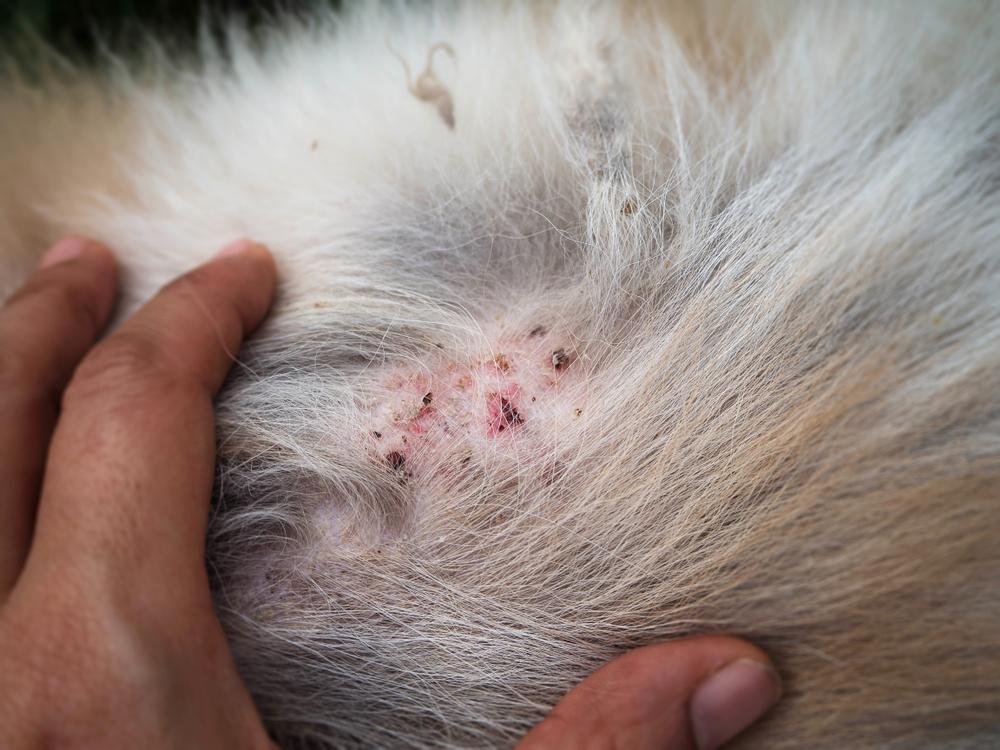

Has your dog been scratching themselves more than usual? Have you noticed redness, pimples or a strange odor coming from their skin? These could be signs of pyoderma — a common skin condition that affects dogs of all breeds, sizes and ages.
If you suspect pyoderma may be irritating your dog's skin, learning more about its causes and treatments can give you peace of mind as you prepare for a visit to the veterinarian. Here's what you should know.
What Is Pyoderma in Dogs?
Pyoderma ("pyo" [pus] and "derma" [skin]) is a bacterial skin infection that affects the hair follicles and surrounding skin. This condition may be just a small, isolated lesion, or it could be a widespread skin condition. Pyoderma is generally classified into three types:
Surface Pyoderma
Surface pyoderma is the most common type seen in dogs and only affects the outermost layer of the skin.
Superficial Pyoderma
This affects the outer layers of the skin and hair follicles.
Deep Pyoderma
Deep pyoderma involves all three skin layers (epidermis, dermis and deeper tissues) and can cause red, raised and sometimes pus-filled lumps.

Is Pyoderma in Dogs Contagious?
In most cases, no — pyoderma in dogs is not contagious. The bacteria involved in pyoderma are typically present on healthy skin without causing issues. Pyoderma usually develops when an underlying issue allows these bacteria to multiply and overgrow, leading to infection.
That said, you should use caution and practice good hand washing and cleaning techniques when dealing with pyoderma in a pet. In some rare cases, dogs can have antibiotic-resistant bacteria that can cause problems for humans (immunocompromised humans, in particular, are at greater risk and should be even more vigilant).
What Causes Pyoderma in Dogs?
There are several possible causes of pyoderma in dogs, including:
Allergies
Hypersensitivity to fleas, certain foods or environmental allergens, such as pollen or mold, can lead to pyoderma.
External Parasites
External parasites, including mites or fleas, can lead to skin issues like pyoderma.
Hormonal Imbalances
Hormonal imbalances, such as hypothyroidism or Cushing's disease, may increase risk, leading to pyoderma.
Other Skin Disorders
Dogs with other skin disorders, such as seborrhea, may be more susceptible to pyoderma.
Immunosuppressive Medications
Immunosuppressive medications, such as chemotherapy or steroids, may make the pet more susceptible to infection.
Foreign Objects
A seed, splinter or other foreign object embedded in the skin can be an irritant, leading to pyoderma.
Skin Trauma
Scratching, grooming, pressure sores or irritants can cause skin trauma, which may make the pet more susceptible to infection.
Conformational Factors
If your dog has skin folds, a short coat or excess skin between the toes, they may be more susceptible to infection.
What Are the Signs of Pyoderma in Dogs?
Pyoderma can appear in many forms, and some areas of the body — such as skin folds, the chin, lips, nose, vulvar folds and the spaces between the toes — are more prone to infection. Pyoderma on a dog's belly can show up as red bumps or oozing sores, while pyoderma in a dog's armpit may present as red, itchy skin.
Look out for these signs of pyoderma in dogs:
Red bumps
Pustules (pus-filled lesions)
Flaky or crusty skin
Hair loss
Skin discoloration
Excessive shedding
Redness
Itching (may or may not be present)
If you're noticing any of these signs, early intervention can make a big difference. Contact your vet for a proper diagnosis and treatment plan tailored to your dog.
Puppy Pyoderma
Young puppies can develop a specific form of the condition known as puppy pyoderma (also known as puppy impetigo). This typically appears as red bumps in areas with less hair, such as the armpits, groin or abdomen, which may crust over or become scaly. Puppies with this condition are often mildly itchy but otherwise healthy. In mild cases, puppy pyoderma may resolve on its own, but visit your vet if the condition persists or worsens.

How to Treat Pyoderma in Dogs
If your vet suspects pyoderma, they'll examine a skin sample under a microscope to look for bacteria or other organisms, such as mites. They may recommend additional tests, like a fungal culture or a black light exam, to rule out conditions such as ringworm. Since several other skin disorders in dogs can mimic pyoderma, it's important to get an accurate diagnosis from a vet before starting treatment.
In general, pyoderma treatment consists of resolving the bacterial infection and addressing the underlying cause, if applicable. Pyoderma is usually caused by Staphylococcus (Staph) bacteria. Unless your dog has acquired a drug-resistant strain, Staph infections are usually cleared up easily with antimicrobial therapy — topical treatments, such as medicated shampoos, sprays or ointments, and oral antibiotics if needed. It's important to complete all prescribed medications and return for follow-up visits if recommended by your vet.
Pyoderma in Dogs: Treatment of the Underlying Cause
While treating the infection is usually straightforward, the greater challenge with pyoderma in dogs is often identifying and managing the underlying cause of the infection. This may require diagnostic testing, including blood work, skin scrapings or urinalysis. Be prepared for some trial and error as your vet works to uncover the root issue.
If the underlying cause isn't addressed, your dog may experience recurring infections — even after successful treatment.
Does Nutrition Play a Role in Pyoderma?
Nutrition plays a significant role in your dog's skin health. The skin is the body's largest organ and requires substantial dietary support to stay healthy. Nutrients, like protein and amino acids, are essential for hair growth, while omega-3 and omega-6 fatty acids help maintain skin hydration and a shiny, healthy coat. Because the skin uses so many dietary resources, feeding your dog a complete and balanced food is one of the best ways to support skin health from the inside out.
Some dogs may also develop pyoderma as a result of food allergies or ingredient sensitivities. If your vet suspects this is the case, they may treat the current skin infection and recommend a food elimination trial to identify any ingredient triggers.
Engaging Your Care Network
Pyoderma can be a pain, but with the right knowledge, care and veterinary support, this dog skin infection remains highly treatable. If you suspect your dog has pyoderma, reach out to your vet. Together, you can get your pup back to feeling their best as soon as possible.




















